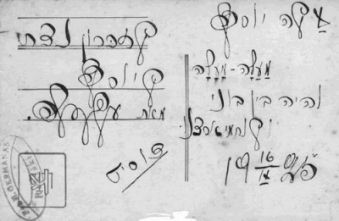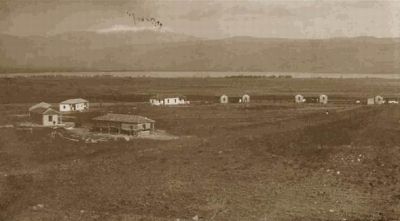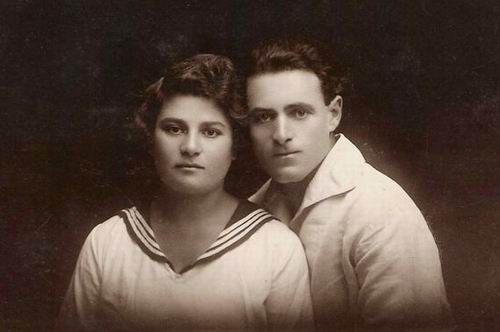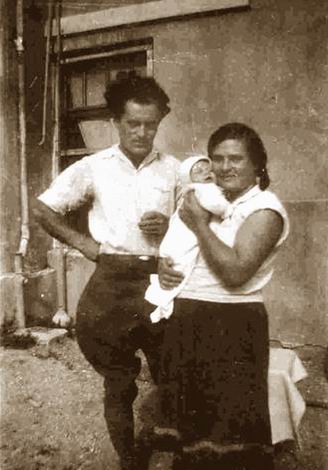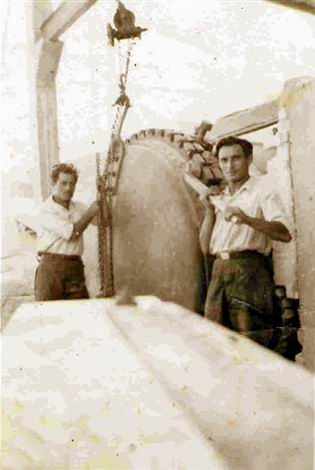I Dreamt of Being a Farmer in Eretz Yisrael (cont.)
|
|
|
For everlasting memoir to Yosef from Ella Slep, Dusiat, 16 September 1925
“Rise higher and higher and be among the builders and fighters in our land” |
Ayelet Hashachar, 1928
“I still remember the song Di Sukka'le [Small Sukkah, in Yiddish] that we, the Epicureans, used to sing in Ayelet Hashachar, the song of the poet Yehoash about Reb Shlome'le the Dayan [religious judge]”… |
|
|
Yosef and Riva (Weinrib)
“In Ayelet Hashachar I became Hebrew teacher to my spouse Riva who came from Zamosch in Poland…” |
In Ayelet Hashachar, the senior members would not greet us. We worked in the mornings, and guarded at night. Nobody cared about anything else we did. Only one of the members acted differently towards us. He was from Galicia, and he really cared about us. When he heard we had nowhere to stay, he took us in, and made sure we were given sheds to live in. We were disappointed at being given the cold shoulder by the senior members, but since we were a tight group, we managed to take care of ourselves.
There were eight or nine of us, and together with the senior members of Ayelet Hashachar, numbered thirty adults in all, and one baby.
In the kibbutz there was a girl who knew English, and she helped me write an aliya request for my brother Avraham. The truth is that I was not sure whether Avraham would “acclimatize” in Eretz Yisrael. And then I received a letter from my father saying there was an option of emigrating from Lithuania to Brazil, and fourteen families had already left the shtetl. My friend, (the Dusiater mill owner's son), Tuvya Yoffe wrote me from Argentina, inviting me to come. Yona Berman suggested I go to South Africa, and everyone promised to find me a job, pay my travel expenses – anything. No one even mentioned Eretz Yisrael. And I actually wrote letters in a positive vein. My brother Avraham made aliya in 1925. A few years later, my sister Miryam followed. I tried to get my sister Henke here too, but failed. My parents did not make it either. Only a handful of their age group made aliya.
In Ayelet Hashachar I became Hebrew teacher to my spouse Riva (nee Weinrib) who came from Zamosch in Poland. Together we left the “Kvutza” (small kibbutz), moved to Ramat Gan, and lived in Slutzky's backyard. A little boy who used to play there later grew up to be Meir Amit. Our first son, Yair, was born there.
I worked at several jobs, laying bricks and picking citrus fruits, and for about a year, I was a plasterer in Haifa.
|
|
|
| Riva, Yosef and Yair, their little child beside the hut in Slutzky's backyard, Ramat Gan, 1932 |
Working in the factory “Betonada” in Ramat Gan, 1933 Yosef Yavnai is on the left |
This material is made available by JewishGen, Inc.
and the Yizkor Book Project for the purpose of
fulfilling our
mission of disseminating information about the Holocaust and
destroyed Jewish communities.
This material may not be copied,
sold or bartered without JewishGen, Inc.'s permission. Rights may be
reserved by the copyright holder.
JewishGen, Inc. makes no representations regarding the accuracy of
the translation. The reader may wish to refer to the original material
for verification.
JewishGen is not responsible for inaccuracies or omissions in the original work and cannot rewrite or edit the text to correct inaccuracies and/or omissions.
Our mission is to produce a translation of the original work and we cannot verify the accuracy of statements or alter facts cited.
 Dusetos, Lithuania
Dusetos, Lithuania
 Yizkor Book Project
Yizkor Book Project
 JewishGen Home Page
JewishGen Home Page
Yizkor Book Director, Lance Ackerfeld
This web page created by Lance Ackerfeld
Copyright © 1999-2026 by JewishGen, Inc.
Updated 27 Feb 2009 by LA
